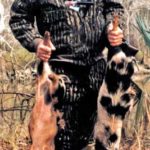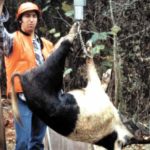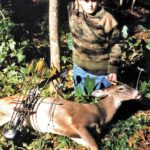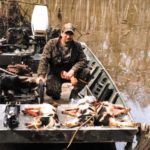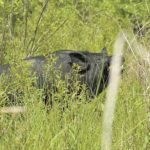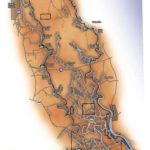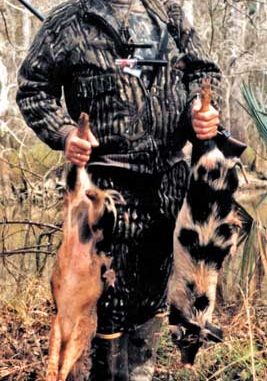
Remember when biologists told us deer and hogs would thrive on this WMA after it was demolished by Hurricane Katrina? Well, that time has arrived.
Hurricane Andrew did it to Sherburne WMA in 1992 — barreled through and leveled it. This saved the LDWF millions.
The very cure biologists prescribed for the area’s malnourished deer herd — an expensive and time-consuming process of selective logging to open the tree canopy and make way for the understory on which deer thrive — Andrew accomplished in one day and for free.
Hurricane Katrina did much the same for Pearl River WMA. (Please note: Thousands of Louisiana families paid a very high price for these wildlife benefits. I don’t for an instant contend that better deer-hunting in a small area of our state remotely compensates for their sufferings. This writer’s house was totaled by Katrina, along with half his family’s earthly belongings. So kindly stifle the letters about my “insensitivity.”)
At any rate, Pelayo started scouting Pearl River WMA two years after Katrina.
“It ain’t no picnic!” he told me on the phone. “But man, the deer and hog sign is EVERYWHERE! And nobody’s hunting it! Let’s go check it out, and pick our trees for the opener.”
Very shrewdly, Pelayo had zeroed in on the portion of Pearl River WMA where the cypress/tupelo swamp starts giving way to bottomland hardwoods — basically the area bordering I-12. Cypress trees, with their immense root networks, are tough, and literally “stand up” to hurricanes much better than the limber swamp maples and willows, and even the water oaks. This means the areas around them — especially around a grove of them — remained relatively clear and still provide relatively open shooting lanes, even by the standards of South Louisiana swamp hunting.
And it was exactly these areas that Pelayo and I had scouted/squirrel-hunted three weeks before the opener and were now approaching, seriously pumped and confident we’d evade the crowds by slithering into the swamp interior the back way — via Highway 90, then upstream by small boat.
Navigating the Middle Pearl upstream from Highway 90 during low water in broad daylight is a hair-raising experience. Navigating it in pitch blackness is almost suicidal.
Weaving through this maze of logs and blowdowns and sand and mud bars is a task best reserved for sportsmen with ample experience on the Pearl — the “river rats” hatched and bred in places like Slidell, Talisheek, Pearl River and Lacombe, the guys who run trotlines in the river, fish for bass and white perch there, who travel its winding length looking for those pristine pockets of wilderness in the WMA where huge swine lurk and where bucks grow those long tines and heavy beams that come with age and a rich diet. These guys know every bend of this river, every blowdown and sandbar; they’ll get you safely through the Pearl’s treacherous path at night and into the remote interior.
Unfortunately, we had no one like that on board. In fact, no one even close. I had an iron grip on the 25-horsepower’s throttle (we wanted a fairly small boat to weave into the swamp’s interior), and Pelayo was sweeping the river in front with the Q-beam. Suddenly, he barked something that sounded unintelligible over the roar of the outboard.
“What?” I shouted back.
“LEFT!” he screeched while flailing his arm in that direction. “TURN LEFT, MAN!!”
Now I heard him.
But too late. The outboard’s handle smashed smartly into my thigh as the lower unit came flying out of the water with a ghastly roar after hitting a submerged log. In panic, I turned the motor and twisted the throttle to full speed. Then the prop plunged back in and launched us atop a sand bar with a crunch that was quickly muffled by the bump of Pelayo smacking the hull, whereupon I finally let go of the throttle.
Pelayo was sprawled on the floor of the 14-foot flat, and strangely silent.
“Good thing we put on these life jackets,” I stammered. “Good cushioning, huh?”
Pelayo rose to a sitting position, twisted his head from side to side and picked up the Q-beam, which was pointing straight up into the star-studded night. Still nothing from his vocal chords as he started rubbing his elbow.
Finally he spoke, but — though my ears still ring from the vocal blast — decorum prohibits my transcription of his vocalizations.
“With that freakin’ Q-beam in front of me, I couldn’t see a thing!” I parried, desperate to evade blame. “Turn it off now and then so I can navigate!”
We pushed the boat off, and continued upriver at more modest speed (about 8 m.p.h.) until we reached the reflective marker we stuck on the tree the previous month. We tied the boat up, strapped on the climbing stands and trudged in.
Our attraction to this area had started three seasons earlier while squirrel hunting this relatively open cypress-canopied area. Sure, squirrels swarmed farther upriver off the oil well road and main entrance to the WMA from I-59, but down here in the cypress/tupelo swamp accessible only by boat, the crowds were much thinner and the terrain more interesting.
We found the squirrels flocking to the cypress balls, and we almost limited out on them. The deer and swine trails churning the area kept distracting our gaze.
On his recent scouting trip, Pelayo saw that the cypresses had stood well against the hurricane, but everything around them had sprouted into tangled, merciless thickets that would be torture to hunt no doubt. But it looked like deer habitat straight from central casting. The place was lush with understory, peppered with tracks and droppings and laced with trails. Even better, the hurricane left the cypresses and a few oaks and gums sprinkled throughout the area just begging for treestands.
We both picked trees along the edge, where the cypress-tree clearing met the downed gum, maple and willow trees entwined with brambles of briars, smilax and trumpet creeper. Deer, as we all know, like to travel areas where two types of terrain meet: clear-cuts with woods, thickets with woods, 10-year old trees with 20-year old trees, marsh with upland.
Nowadays at the pearl River WMA, they seem to particularly like the areas where (semi-open) cypress-tupelo bottom meets hellish brambles of downed trees and assorted vines. When scouting, forget acorns for a second, and study these transition areas closely for trails and browsing sign on the brambles. You’ll almost always find some.
I picked a slender oak overlooking an area where three trails (deer and swine, it appeared) were churned with tracks, and Pelayo picked a sturdy gum overlooking a thick patch of trumpet creeper that was liberally sprinkled with shiny black droppings (the kind that look like Milk Duds and dark Sugar Babies along with the smaller Raisinette type). From browsing, the trumpet creeper carpeting the downed trees around his still-standing tree looked like a power mower had gone over it.
So we were both cranked to full voltage in anticipation.
“Didn’t seem this far, did it?” I asked Pelayo who was trudging alongside me after about 10 minutes of stumbling through the darkness.
“Calm down, man. We still have a ways too go. You and your opening-day jitters. Happens every year,” he sighed.
“Ouch!” — that’s greenbriar lacerating my hand.
“Darnit!” — that’s elderberry jabbing my thigh.
“Whoops!” — that’s a strand of trumpet creeper snaring my right leg and sending me face first into the blackberry brambles.
I could hear Pelayo waging a similar battle with this deer smorgasbord on my left. Ah, understory. So nice for deer. Such hell for deer hunters.
Somehow we found our trees, located about 300 yards from each other, and humped up with the climbing stands with the horizon just turning pink.
In the twilight, I seemed to be surrounded by three deer only 10 minutes after climbing in my stand. Then the sun had to emerge and spoil it. The one right under me turned into a log, the one on my left a stump and the one in front of me a wilted palmetto leaf.
An hour later a browsing doe’s nose turned into a blackbird swaying on a branch. A 6-point twitching his ear turned into a thrush twitching his tail. And a buck making a scrape became an armadillo rooting for bugs.
The human capacity for wishful thinking peaks on a deerstand. In no other setting is the human imagination busier, the senses keener, the powers of reasoning more defunct.
By 8:15, I was already getting fidgety. Squadrons of wood ducks blazing overhead had kept me entertained earlier. Now they’d finished with their brief flight — but what’s that? Turned out from up here I could see Pelayo in his perch in his blaze orange, a good 300 yards away.
Looking over, I saw Pelayo raise his rifle. Probably just looking through his scope at some squirrels, I surmised.
BLAM! The blast almost jolted me out of the tree. Then I saw the white flag bouncing over the logs and brambles and entering the thickets about 200 yards away. I was shaking like I’d been the one who shot.
I looked over, and Pelayo raised both arms in victory, like Rocky. In five minutes, he started humping down the tree, and I followed. When I got to him, his face was contorted in anxiety. No blood anywhere.
“I KNOW I didn’t miss!” he wailed. “It was only 60 yards away!”
“Let’s just follow the tracks,” I suggested. “They’re pretty clear.”
The deer was sprawled about 20 yards inside the thickets, stone dead. He was shot at an angle in the neck, the bullet traversing the body lengthwise and never exiting. Hence, internal bleeding and no blood trail.
He’d turn no heads in Thistlethwaite or Red River. He’d be laughed at in South Texas or the Midwest. But by the standards of public-hunting areas in Southeast Louisiana, he was a dandy — four measly points and 113 pounds field-dressed.
We were only a couple of hundred yards from the boat, and it was early. More significantly, I had not “harvested” anything thus far.
“Whaddaya say we try and maybe rustle up some squirrels — maybe a swine?” I asked Pelayo.
“Yeah, why not?” he snickered. “I guess you need some meat too.” I’d brought a shotgun. Any shot at a deer or swine would be under 50 yards, I’d figured. And I brought along a handful of five-shot shells, anticipating this very turn of events. We hung a bit of orange tape on a tree above the deer, and ambled off in opposite directions.
“See ya right here at … 9.30?” Pelayo looked over and nodded.
“Good deal,” I answered.
Despite the battering by Katrina and a smaller one by Gustav, the stretch of swamp and hardwood bottomland known as the Pearl River Basin still beckons those of us who went through high school, college and beyond hunting it on weekends. Mainly that’s because in Southeast Louisiana, there’s almost no big stretch of bottomland left. I fully expected to run across some hogs — almost always happens at Pearl River, especially in these remote portions.
But some cypress branches were swaying up ahead. So I started stepping v-e-r-y s-l-o-w-l-y forward for about 60 yards, keeping my eyes on the swaying branches the whole time. Finally, it was time to raise the gun.
Whoops! One saw it! Now he’s running along a branch like a streak. I shouldered the gun, led him like a teal — BLAM!
One down! I looked over, and another was in mid-leap, heading for a nearby gum that was covered in trumpet creeper, ivy and muscadine vines.
He gets in there and he’s lost, I thought.
But he landed on a very thin branch after his leap. It was taking him a few seconds to regain his balance. Just as he started scampering again — BLAM! There was a shower of leaves, and I lost sight of him.
Where did … ?
THUMP!
Man that’s a sweet sound to a squirrel hunter. And no rustling of leaves afterwards. He was dead. While picking him up from a muddy slough, I noticed three big swine wallows. Nearby saplings were all smeared with mud from waist to knee level. Some of the mud was still wet. Swine tracks were everywhere.
Then a flash of orange caught my eye to my left. It was Pelayo, weaving his way through some thickets, his eyes focused groundward, not treeward. He’s after hogs, I thought. Then some swaying branches turned my head away. Yes indeed, another squirrel. And I started stalking. I was closing the distance when — BLAM! — Pelayo’s rifle blasted.
I jumped, and looked over. Forget the squirrel, I thought. But I couldn’t see Pelayo’s hat anymore.
BLAM!
He shot again, and I jumped again. Geezum! I thought. He musta got into a herd!
BLAM!
Now a third shot! Now I was really getting excited, and started walking in his direction.
“Coming your way!” Pelayo yelled. “PIGS! A HERD! Coming right at YA!”
I lifted the gun, but I couldn’t see anything?
Then, is that … ?
YES! MOVEMENT! White and black movement!
And another … and ANOTHER!
They’re heading right for me! They’re in the open now, crossing a dried slough — and still coming! Closer … .
Thirty yards … twenty five.
I put the bead on a little hog’s head. I only had high-powered 5s, but this was a small one and at close range.
BLAM!
He flipped like a head-shot rabbit.
BLAM!
I blasted him again as he thrashed around crazily. Then I started running toward him. He was kicking wildly, thrashing around, kicking up leaves, kicking up mud, going berserk. He looked like the Tasmanian Devil.
BLAM!
I blasted him from 10 yards, and he finally calmed down.
But I sure as hell wasn’t calm. My knees were knocking crazily as I walked to him, just as Pelayo walked up, grinning like the Cheshire cat.
“Got TWO!” he roared as we high-fived. “Just like that one.”
He pointed with his chin at mine.
“It was a whole herd of the little suckers. I put them up in the thickets.”
We erupted in guffaws, laughing like idiots in the middle of the swamp. Yeah, it was all coming back, our college hunts all over again. And perfect-sized hogs, too, I thought as we whipped out the knives. They’ll be easy to drag out, and the perfect size for the Halloween cochon de lait.
That fat 4-point didn’t hurt either.
